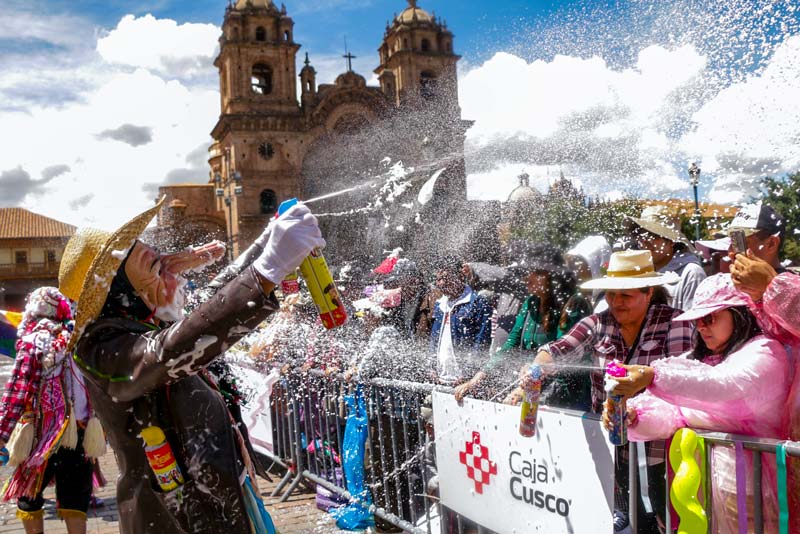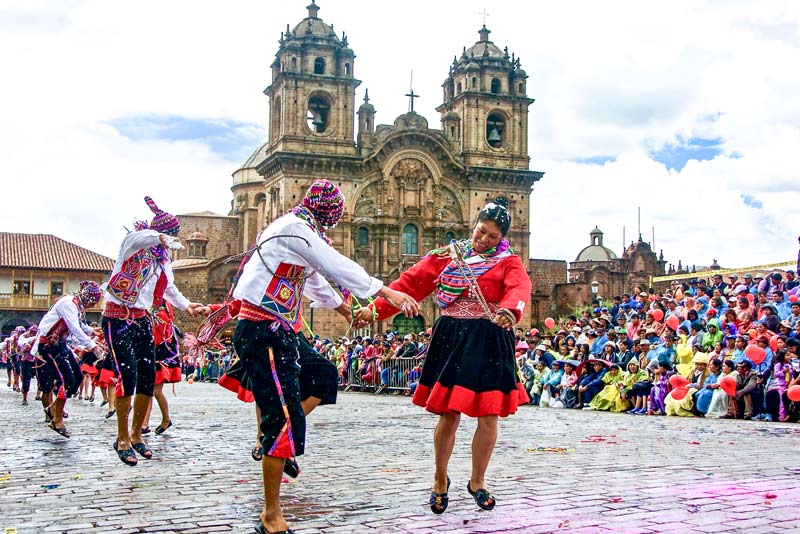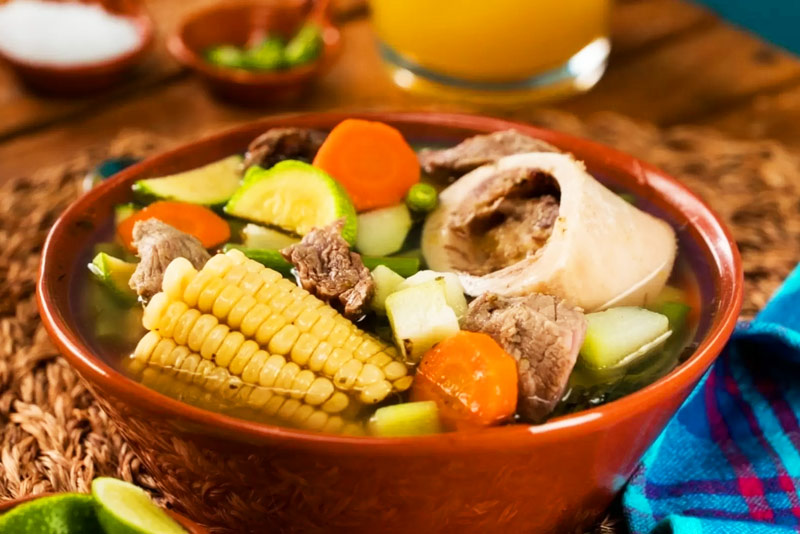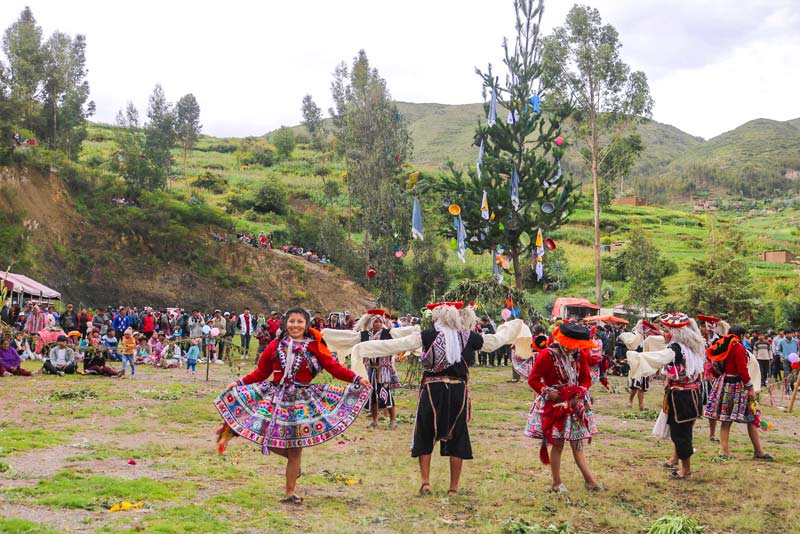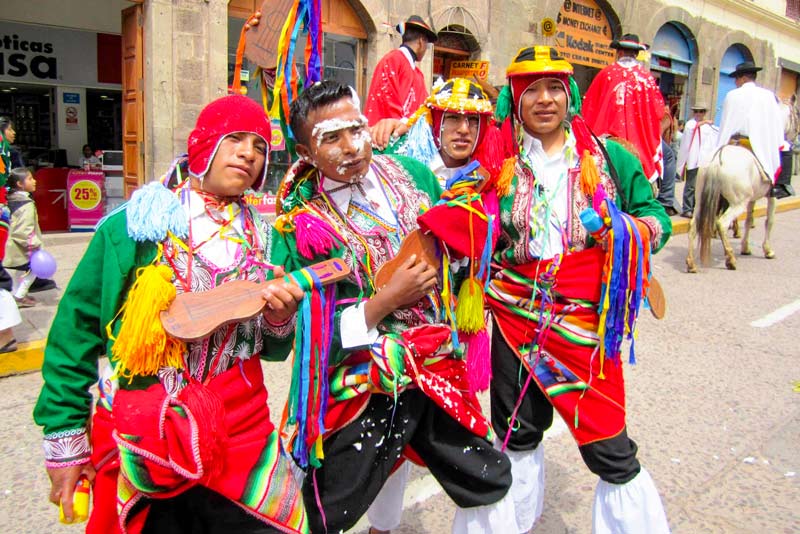How to experience Carnivals in Cusco
Carnivals in Cusco are one of the most vibrant and colorful festivities on the calendar. Blending tradition, music, dance, and playful water and paint games, this celebration is a perfect opportunity to immerse yourself in Cusqueñan culture. Both in the city and in the surrounding provinces, the festival is experienced with great joy, with activities that bring color to the city, making it an unforgettable experience for locals and visitors alike.
- Carnivals in Cusco
- When are the Carnivals in Cusco?
- How are Carnivals celebrated in Cusco?
- Places to visit during Carnivals in Cusco
- Recommendations
- Frequently asked Questions
Carnivals in Cusco
Cusco’s carnival is a cultural expression that involves the entire community. The festivities begin with preliminary activities in neighborhoods, where groups organize parades and rehearse traditional dances.
This celebration, which takes place between February and March, varies in date each year depending on the liturgical calendar, marking the start of a season filled with music, dances, and ancestral traditions.
When are the Carnivals in Cusco?
In 2025, the Cusco Carnivals will be celebrated on Sunday, March 9.
The preliminary festivities include:
- Compadres’ Day: Thursday, March 6, 2025.
- Comadres’ Day: Thursday, February 27, 2025.
- Kacharpari (Carnival Farewell): Sunday, March 16, 2025.
Experiencing Carnivals in Cusco is a unique opportunity. Don’t forget to also visit the Sacred Valley of the Incas and the South Valley to fully immerse yourself in the joy and traditions these places have to offer. Book your next visit through our website and take home unforgettable memories of Cusco’s Carnivals.
How are Carnivals celebrated in Cusco?
The epicenter of the Carnival festivities is the Plaza de Armas of Cusco, where troupes, groups, and traditional dances fill the space with colorful costumes and choreographies that reflect the cultural richness of the region.
The contagious joy encourages both locals and tourists to join the celebration in a shared festive atmosphere.
Highlighted Activities During Carnival
- Water and paint games: It is customary for young people and adults to participate in water and paint battles throughout the city.
- Parades and contests: Various groups compete in the main square to showcase their best costumes and dance performances.
- Yunza: A tree adorned with gifts becomes the center of attention in different squares and neighborhoods. Participants dance around it until someone manages to cut it down, triggering an explosion of excitement.
Compadres’ Day
On the Thursday before Carnival, Cusco’s women prepare rag dolls representing men, dressing them up and attaching humorous phrases. These dolls, known as compadres, are displayed on balconies, poles, and squares, bringing laughter to the community.
At night, gatherings are held where women host men with food, music, and fun.
Comadres’ Day
A week later, men return the joke by creating dolls representing women, which are hung in public spaces with humorous messages. Later, gatherings and festivals take place where women take center stage.
This festive exchange symbolizes harmony and companionship between men and women, promoting joy and community spirit.
The Carnival’s Closing: Kacharpari
Kacharpari, meaning “farewell” in Quechua, marks the end of the celebration with one last day of festivities. Games, live music, and often a second Yunza are organized for those wanting to continue the fun.
This event is an opportunity to give thanks for the joy experienced and to bid farewell to Carnival with the promise of an even more festive year to come.
Carnival Cuisine: Traditional Food You Must Try
Carnival in Cusco is not only about dances and games but also about gastronomy. During this season, it is traditional to enjoy typical dishes that are part of the festive spirit:
- Timpu or Puchero: A hearty broth with meat, corn, potatoes, cabbage, and chickpeas.
- Chicha de jora: A fermented corn beverage, very popular during festivities.
Places to visit during Carnivals in Cusco
Although the Plaza de Armas of Cusco is the heart of the celebration, Carnival is also enthusiastically celebrated in various provinces and districts, each with its own customs and cultural nuances. Below are some of the best places to experience the festivities:
Sacred Valley of the Incas
The Sacred Valley (Sacred Valley Travel Tips) joins the celebration with festivities that include dances, troupes, and food fairs. Some of the most notable events are:
- Pisac: Famous for its artisan market, the town of Pisac celebrates Carnival with parades of native dances and a feast of traditional food. In its streets, locals and visitors engage in playful water and paint battles.
- Calca: Hosts one of the region’s largest Yunzas, where the community gathers to bring down the tree filled with gifts. Music and chicha de jora are essential parts of the festivities.
- Urubamba: This town celebrates Carnival in a more family-oriented way. Food fairs offer a great opportunity to try traditional dishes like Timpu or Puchero.
South Valley
The South Valley of Cusco is another great place to experience a vibrant Carnival celebration.
- San Jerónimo: In this district, Carnival is marked by parades and troupe contests, where the best dance group of the season is chosen. Yunzas are also commonly held in different neighborhoods.
- Saylla: Known for its exquisite gastronomy, this town is the perfect place to enjoy Carnival while tasting the famous Saylla chicharrón.
- Oropesa: Famous for its traditional bakeries, Oropesa celebrates Carnival with festivities in its main squares, featuring Yunzas and live music.
Quillabamba: Carnival in the edge of the jungle
Located in La Convención, Quillabamba in Cusco’s jungle is one of the best options to experience Carnival in a warm, tropical climate.
- Water and paint battles: Unlike Cusco, where the weather is colder, in Quillabamba, water games are enjoyed to the fullest thanks to the sun and jungle humidity.
- Music festivals: Quillabamba organizes concerts featuring cumbia and huayno groups during Carnival season.
- Troupe parades: The population forms groups that march through the city dancing and singing in traditional attire.
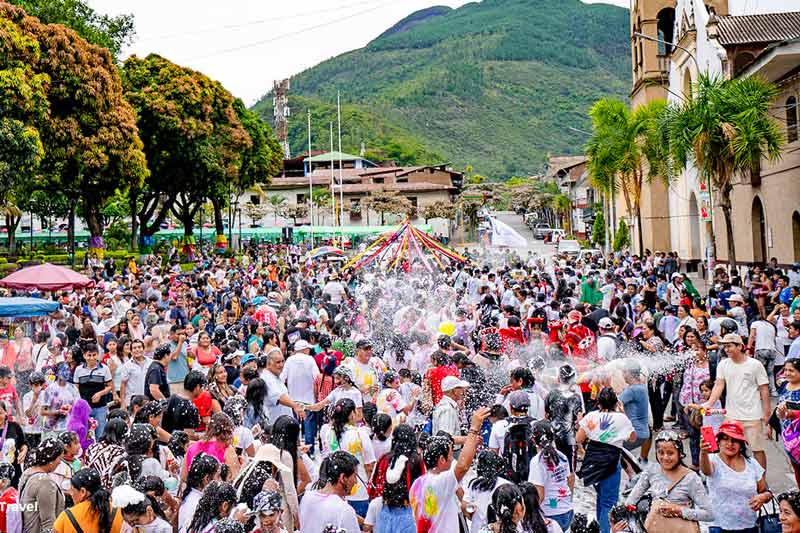
People playing in Quillabamba’s main square
Paruro, Anta, and Chumbivilcas: Rural Carnivals
In many rural communities, Carnival maintains a strong connection with agricultural and livestock traditions.
- Paruro: Here, Carnival is a community celebration where locals organize rituals of gratitude to Pachamama, along with the traditional yunza.
- Anta: It stands out for its horse parades, where riders wear traditional outfits as they parade through the main square.
- Chumbivilcas: In this province, Carnival is celebrated with Andean music, native dances, and the ever-present water and flour games.
Canchis: The Carnival of Tinta and Sicuani
- Tinta: This district experiences Carnival in a unique way. Here, women lead the celebration, forming troupes that parade through the streets in colorful outfits while performing traditional dances. The yunza in the central square is one of the largest in the province.
- Sicuani: In the capital of Canchis, Carnival is characterized by dance competitions and the Kacharpari, where hundreds of people bid farewell to the festivities with one last day of music and dance.
Carnival in Cusco is a vibrant celebration that blends history, culture, and fun. Whether in the Plaza de Armas, the neighborhoods, or the nearby provinces, the joy of Carnival is experienced with great intensity. If you want to enjoy an adventure full of color, tradition, and festivity, Carnival in Cusco awaits you with open arms. Don’t miss it!
Recommendations
- Prepare for water games by wearing comfortable clothes that you don’t mind getting dirty or wet.
- Bring a waterproof jacket or poncho if you don’t want to participate actively.
- Store your belongings in plastic or waterproof bags.
- Wear light but warm clothing, as February is the rainy season.
- Enjoy traditional cuisine and try timpu or puchero, the typical carnival dish.
- Try chicha de jora and other local products.
- The Plaza de Armas and other key locations fill up quickly, so arrive early.
- Visit places like Pisac, Calca, or Quillabamba to experience different variations of the carnival.
- Bring sunscreen, as the sun can be intense.
- Wear a hat or cap to protect yourself from the rain or sun.
- Avoid carrying valuables in crowded areas.
- Book accommodation and transportation in advance, as it is a high season in Cusco, and hotels and tours may fill up quickly.
- Bring cash for fairs and local events, as some vendors do not accept cards.
Frequently asked Questions
1) When is Carnival celebrated in Cusco?
Carnival in Cusco in 2025 will be celebrated on Sunday, March 9.
2) Where is the best place to experience Carnival in Cusco?
The Plaza de Armas in Cusco is the epicenter of the celebration, but you can also enjoy it in other places like the Sacred Valley (Pisac, Calca, Urubamba), the South Valley (San Jerónimo, Saylla, Oropesa), and provinces such as Quillabamba.
3) Is it mandatory to participate in water and paint games?
No, but it is difficult to avoid them on the main streets. If you don’t want to get wet or dirty, wear waterproof clothing and stay away from the busiest areas.
4) What traditional food is eaten during Carnival?
The most representative dish is timpu or puchero, a stew made with meat, potatoes, chickpeas, cabbage, and peaches. Chicha de jora is also commonly consumed.
5) What activities can you do besides water games?
You can enjoy traditional dance parades, troupes, food fairs, yunzas, and cultural events in different parts of the city and provinces.
6) Should I book accommodation in advance?
Yes, because it is a high season in Cusco. It is recommended to book hotels and tours in advance to ensure availability.
7) Can tours be taken during Carnival?
Yes, it is advisable to plan your visit with a travel agency and avoid peak hours at places like Machu Picchu or the Sacred Valley.
8) What is the Yunza or corta monte celebration like?
It is one of the most important traditions of Carnival. A tree decorated with gifts is set up, and participants dance around it while taking turns cutting it with a machete until it falls. The person who delivers the final blow must organize the yunza the following year.
9) Does Carnival in Cusco have a special meaning?
Yes, besides being a joyful and colorful celebration, it has a strong cultural component, combining native traditions with colonial influences. It is also an opportunity for the community to strengthen social bonds.
Advice from people who have been there
 By: Alexis S.
By: Alexis S.“Days of color and festivities“
“The carnivals in Cusco are a constant party, I participated in all the activities in the main square until I ended up completely soaked. One of the most joyful days I spent in Cusco, highly recommended. I advise you to keep your belongings in waterproof bags to better enjoy the party.“
By Ticket Machu Picchu – Last updated, February 19, 2025
